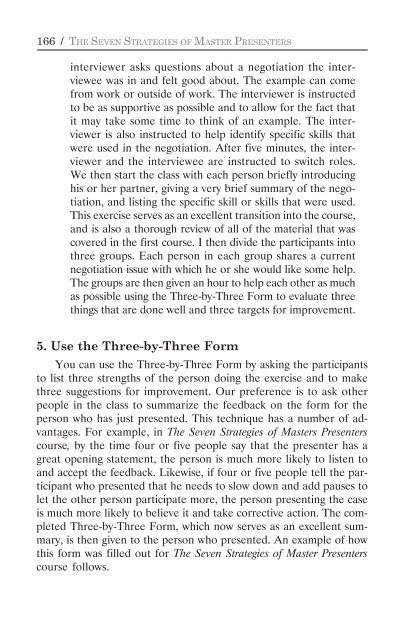The Seven Strategies of Master Presenters - Lifecycle Performance ...
The Seven Strategies of Master Presenters - Lifecycle Performance ...
The Seven Strategies of Master Presenters - Lifecycle Performance ...
Create successful ePaper yourself
Turn your PDF publications into a flip-book with our unique Google optimized e-Paper software.
166 / THE SEVEN STRATEGIES OF MASTER PRESENTERS<br />
interviewer asks questions about a negotiation the interviewee<br />
was in and felt good about. <strong>The</strong> example can come<br />
from work or outside <strong>of</strong> work. <strong>The</strong> interviewer is instructed<br />
to be as supportive as possible and to allow for the fact that<br />
it may take some time to think <strong>of</strong> an example. <strong>The</strong> interviewer<br />
is also instructed to help identify specific skills that<br />
were used in the negotiation. After five minutes, the interviewer<br />
and the interviewee are instructed to switch roles.<br />
We then start the class with each person briefly introducing<br />
his or her partner, giving a very brief summary <strong>of</strong> the negotiation,<br />
and listing the specific skill or skills that were used.<br />
This exercise serves as an excellent transition into the course,<br />
and is also a thorough review <strong>of</strong> all <strong>of</strong> the material that was<br />
covered in the first course. I then divide the participants into<br />
three groups. Each person in each group shares a current<br />
negotiation issue with which he or she would like some help.<br />
<strong>The</strong> groups are then given an hour to help each other as much<br />
as possible using the Three-by-Three Form to evaluate three<br />
things that are done well and three targets for improvement.<br />
5. Use the Three-by-Three Form<br />
You can use the Three-by-Three Form by asking the participants<br />
to list three strengths <strong>of</strong> the person doing the exercise and to make<br />
three suggestions for improvement. Our preference is to ask other<br />
people in the class to summarize the feedback on the form for the<br />
person who has just presented. This technique has a number <strong>of</strong> advantages.<br />
For example, in <strong>The</strong> <strong>Seven</strong> <strong>Strategies</strong> <strong>of</strong> <strong>Master</strong>s <strong>Presenters</strong><br />
course, by the time four or five people say that the presenter has a<br />
great opening statement, the person is much more likely to listen to<br />
and accept the feedback. Likewise, if four or five people tell the participant<br />
who presented that he needs to slow down and add pauses to<br />
let the other person participate more, the person presenting the case<br />
is much more likely to believe it and take corrective action. <strong>The</strong> completed<br />
Three-by-Three Form, which now serves as an excellent summary,<br />
is then given to the person who presented. An example <strong>of</strong> how<br />
this form was filled out for <strong>The</strong> <strong>Seven</strong> <strong>Strategies</strong> <strong>of</strong> <strong>Master</strong> <strong>Presenters</strong><br />
course follows.










